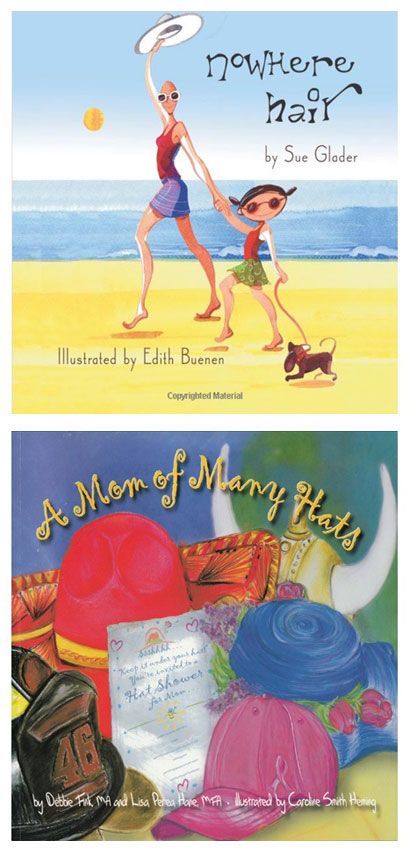
Using books to explain cancer to a child
A key issue pertaining to a mother’s diagnosis of cancer is how to appropriately communicate the diagnosis and related matters to children. It is a real challenge to find the balance between informing the children truthfully, while at the same time minimizing harm and fear, especially for young children. In comparison to older children who might have learned about cancer previously, young children often have no or limited experience of cancer and might need more help in understanding the situation.
Children’s books can be a great resource to help parents, teachers, and healthcare providers with this communication; illustrated books can be especially useful for young children (aged 3-12).
Two such books are “Nowhere Hair” and “A Mom of Many Hats.” Both illustrated books portray a heart-warming story of a child or children facing the situation of maternal cancer. The main content considers cancer-related knowledge, the impact of maternal breast cancer on the whole family, and coping strategies for children. These books can help children talk about their feelings along with exploring ways to cope and both give and receive support.
Nowhere Hair by Sue Glader
Summary
This book is suggested for children aged 3-7 years old. The narratives are in rhyme which lends a gentle lilt and rhythm to reading the book. The simple, stylish watercolor illustrations (by Edith Buenen) help the pre-reader follow along with the story, and show different emotions and coping skills.
Nowhere Hair tells the story of a young girl whose mother loses her hair. As the child tries to find the hair, she learns that her mother has cancer. During treatment, we see the mother still being silly, loving, fashionable, and happy, but also tired and cranky.
The type of cancer is not specified, so the book is appropriate for any cancer.
The author was diagnosed with breast cancer at age 33 when she had a one-year-old. She lives locally in Marin, and both her and her now teenage son are actively involved in Zero Breast Cancer.
Content of the book
Cancer-related knowledge:
- The book does not explicitly inform the reader about what cancer is. Rather it underscores that cancer is not something contagious so that “when she kisses me, I can’t catch what she’s got.” Also, to allay any feelings of guilt, the child is reassured that nothing she has done, said, or thought has caused this to happen.
- Chemotherapy is described as the “…. medicine I take to cure my cancer” and that this is what has caused the mother to lose her hair.
- Another side effect of the treatment shown in the book is the mother feeling tired and not being able to do as much for the child.
Impact of maternal cancer:
- The emotions of both the child and the family are discussed, including feelings of fear, guilt, worry, and confidence. The book underscores that these emotions are normal.
- Care is taken to reassure the child that the parents’ love for her has not changed, even if their day to day activities might change.
Coping strategies:
- Hats are used as a way for both the child and mother to express their emotions openly. So a different hat can be worn to show that the wearer is feeling sleepy, crabby, silly, or happy. It is good to see positive emotions included here.
- The daughter expresses empathy and concern regarding how others will relate to her mother: “if you see her [the mother], please be kind. Don’t snicker and don’t stare.”
Conclusion
Sue Glader has the balance just right in this book. She sensitively acknowledges both the child’s and parents’ emotions associated with cancer. The ending then reminds us that none of this changes their love, rather “it’s what’s inside that counts,” not how we look on the outside. Nowhere Hair is gentle. It can ease difficult conversations. The information it includes is age appropriate and presented beautifully.
A Mom of Many Hats by Debbie Fink and Lisa Perea Hane
Summary
The author suggests this book is appropriate for children of any age. The illustrations (by Caroline Smith Heming) and storyline provide not only tools for adults to help children cope with a cancer diagnosis, but are also empowering for children to take action.
The book is being translated into Spanish and Portuguese.
In the three-chapter storybook “A Mom of Many Hats”, we follow young siblings Brad and Olivia as they learn that their mother has breast cancer. Over time, the children’s emotions change. As they see other people helping their mom, they want to help also, so they plan a surprise hat party. The hat party allows for expression of emotions and leaves the whole family stronger.
Debbie Fink is a writer and performer who was inspired to write this book by the other author, Lisa Perea Hane, who had a breast cancer diagnosis.
Content of the book
One of the key strengths of this book is that it includes a “note to adults” on how to use the book for children of different ages. As the story is written in three parts, the authors recommend reading the book over several months - just like cancer treatments might take several months. This approach allows for changes in the children’s emotions and coping skills. The reader is advised to be aware of when enough is enough.
There is also a brief index in this section relating to different stages of loss that children might experience, such as shock, depression, and denial and linking them to specific pages and characters in the book. It might be useful to focus on these pages when and if these emotions arise for children.
Cancer related knowledge:
- Cancer is described as not being contagious, but no further explanation is given.
- However, both surgery and chemotherapy are discussed, with chemo being the “medicine that kills cancer cells.”
- Hair loss and tiredness/fatigue are described by the mother as being related to her treatment.
- For the party, Brad decided to serve “heaping bowls of blueberries and broccoli, our favorite antioxidants,” with illustrations also of tea, grapes and dark chocolate. This is a lovely way to bring into the story the idea of food helping their mother.
Impact of maternal cancer:
- The impact of the cancer diagnosis on all members of the family is described, and it is acknowledged that these feelings vary from day to day.
- Their daily life changes but there a good parts such as “the high point was when Grandma arrived.”
- Honest, open communication is highlighted via what and how the adult family members communicate with the children about cancer and its treatment, and how they explain what is going on and what to expect.
Coping strategies:
- Brad and Olivia describe how talking to their grandmother helped normalize their feelings of anger.
- Coping strategies illustrated in the book include talking to adults and their other sibling, distraction by keeping busy, and feeling empowered into doing something special for their mom to help her. The children realize that they can comfort others.
- Hats are used in the party to help support the mother, with the hats indicating courage, perseverance, hope, faith, and courage.
- The children learn that even if they can’t talk about their emotion, they can let the family know in other ways - like wearing a hat - so that others know what they need.
- Several times in the book, the mother starts to say what she needs - then changes it to show that all of them have needs - “I’ll — we’ll — take all the courage we can get!”
Conclusion
Fink and Hane have created a heart-warming book that is not only a tool for discussing cancer with children but is also empowering for children. The over-arching theme is that the strength of the family will get them through this and they will be able to go from being fearful to being strong. That they can all support each other.
While the age range recommended for the book is large, I do feel the different approaches to reading that are suggested can make the story accessible for a wide age range audience. I include the adult reader in this too, as the story is delightful.
Final Note
Both of these books are beautiful resources for families, schools, and healthcare providers. Sadly, when looking for this type of book for this review, I went to two libraries - one in Sonoma County and one in Marin County. Neither had any books of this type to offer.
One factor that these and other similar books seem to neglect is addressing the impact of cancer on children’s school life. One way to help resolve this would be to utilize this resource more frequently in schools, especially when a parent of one of the students has a cancer diagnosis. This might promote the discussion of children helping their peers, and encourage children to talk openly to their teachers.
These types of books should be more readily available as they enable young children to identify with the characters in the book and understand that what they are experiencing is not just happening them. They also provide an opportunity for children to express their own concerns when they read alongside their patients, which helps to develop an honest and open rapport between them.
To learn more about Nowhere Hair click here, and to learn more about A Mom of Many Hats click here!
Review by Ruth Baillie, CALMERme.com.

